What the Design Centers Do
The Design Centers in Romania and India house highly skilled engineers, technicians, and specialists who work across various disciplines. Their expertise spans all systems and subsystems of railway infrastructure and extends to other areas as needed.
- Infrastructure Design: Developing environmentally friendly railway engineering and design solutions that are cost-effective, efficient, and sustainable.
- Structural Engineering: Supporting the design and analysis of bridges, tunnels, civil railway buildings, and other key infrastructure projects, ensuring they meet the stringent safety and engineering standards required for large-scale infrastructure projects.
- Equipment Planning: Providing expertise in telecommunication and signaling systems to integrate modern communication technologies within the broader infrastructure network.
- Building Information Modeling (BMI): Implementing advanced digital tools to streamline design, construction, and asset management processes. This includes digitalizing existing plans, 3D modeling of structures, and utilizing Virtual, Augmented, and Mixed Reality for tasks like collision detection and 3D visualizations. By offering comprehensive BIM solutions, ranging from 3D to 5D planning, the Design Centers help create more efficient workflows and foster better collaboration between project stakeholders.
- Digitalization: Playing a crucial role in ongoing efforts to modernize infrastructure through digitization, including the use of innovative technologies and data management tools to optimize project outcomes.
- Rail Systems: Offering engineering, design, and consulting services in all aspects of railway systems, including project planning and systems integration.
- Rail Energy: Designing and conducting simulation studies for traction power, auxiliary power, harmonic analysis, and electromagnetic compatibility (EMC/EMI). This includes designing overhead line equipment and third rail systems for metros and mainline railways, both conventional and high-speed.
- Signaling Systems: Providing design services for advanced signaling systems such as CBTC and ETCS for metros, conventional railways, and high-speed lines.
- Alignment and Track Design: Design and modeling of track alignment, including tracks in maintenance depots and stabling yards, using industry-standard software such as Bentley OpenRail, Civil 3D, and ProVI. This also includes the design of both ballasted and ballastless trackbeds for various axle loads and speed requirements.
- Computer-Aided Design Services: Creating detailed digital models and drawings that form the backbone of design and planning processes. These services ensure that design accuracy and integrity are maintained across all project phases.
In addition to these core services, the Design Centers contribute to other specialized fields, offering a comprehensive range of technical services essential for DB's diverse project portfolio.
